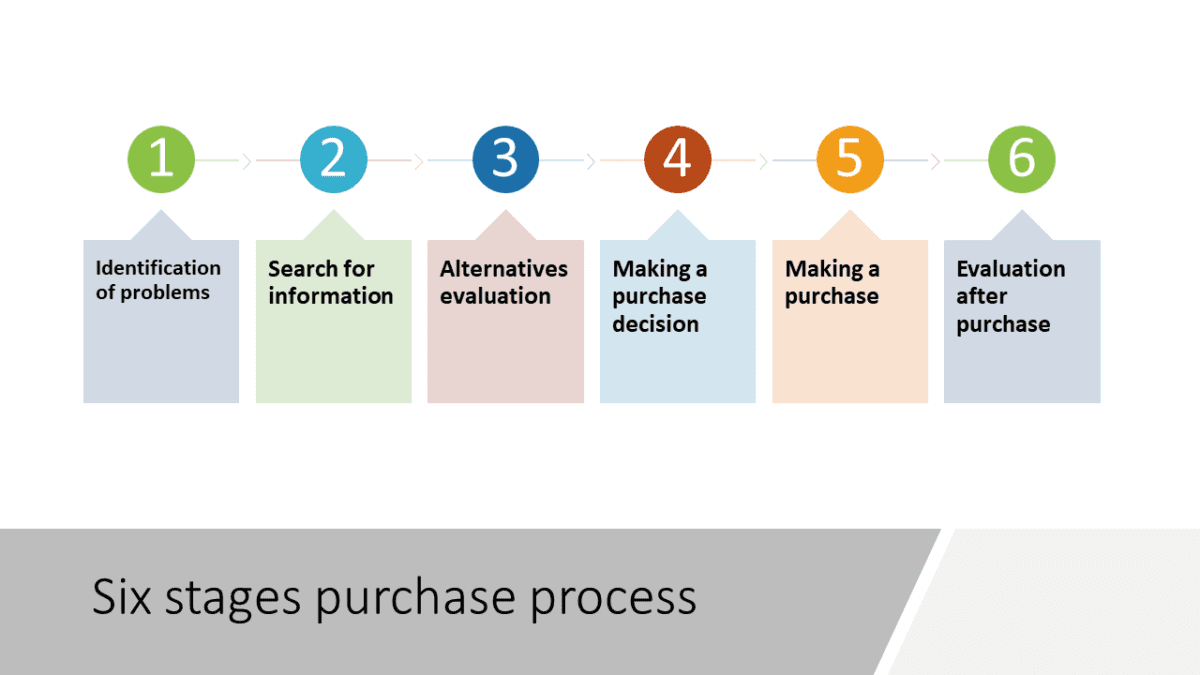There is a widespread misconception among retailers that consumer purchases are random. Buying a certain product happens either because it appeals to a certain customer or because it doesn’t. As with product marketing, they use trial and error to discover what works and what doesn’t.
Would consumers follow a distinct process when deciding whether to buy something? Can marketing to a target audience become more than a shot in the dark if there is a scientific method for identifying what factor goes into the buying process?
Six stages purchase process
What’s good news? It exists. There are only a few steps involved in the actual purchase. As a marketer, you can effectively market to consumers at six stages in the purchase process.
1. Identification of problems
To put it simply, before making any purchase, a customer may have a reason to think their desires, their destination or their perception of a situation are different from their actual reality. When a customer’s desire differs from reality, there is a problem.
This, however, creates an opportunity for the marketer. Starting the buying process by bringing a problem to your customer, whether they are aware of it or not, is the first step. Content marketing is a good place to start.
Provide facts and testimonials to prove the benefits of your product. Engage potential customers by asking questions. As a result, a potential customer becomes aware that they have a need that needs to be met.
2. Search for information
The customer search process begins once a problem is identified. They are looking for a solution to an issue they know exists. We are looking for new foundations for makeup; we are looking for new refrigerators with all the latest technology; it is pretty straightforward.
Marketers should establish their brands as industry leaders or experts in a particular field in order to meet this need. You can advertise partnerships and sponsors prominently across all web pages and collateral by becoming a Google Trusted Store or becoming a Google Certified Store.
CJ Pony Parts, a leading Ford Mustang parts dealer, has become a Google Trusted Store as part of its commitment to increasing search engine rankings and providing a sense of security to customers.
Maintaining your credibility keeps you ahead of the competition and in front of customers during the information search process.
3. Alternatives evaluation
There is no guarantee that a customer will buy your product or service just because you stand out from the competition. The importance of doing thorough research prior to making a purchase is greater now than ever before. In this situation, they’ll compare other options even when they’re sure of what they want, to make sure they’re making the right decision.
There is no easier way to market to this market. During the evaluation of alternatives stage, keep them on your website. Insurer Geico allows customers to compare rates with other companies on their own site, even if their competitors are offering a lower rate. During the evaluation of alternatives stage, this simplifies the process as well as establishes a trusting relationship with the customer.
4. Making a purchase decision
In the consumer buying process, the purchase decision is located near the midpoint. After exploring multiple options, understanding pricing and payment options, and considering whether to move forward, the customer has decided whether to purchase. Yes, they can still leave at this point.
Now is the time to increase the level of security provided by your marketing team while reminding your customers why they made the purchase in the first place. As much information as possible about the need created in step one, along with your brand’s role in fulfilling this need, is important at this stage.
The time is right to bring back a customer who walked away from the purchase. It is possible to enforce the purchase decision even if the opportunity seems lost by using retargeting or simply sending an email reminder that emphasizes the need for the product in question. In the consumer buying process, step four is the most crucial. The profit margin is where the difference between making and losing money lies.
5. Making a purchase
Customer has created a need, researched the product, and decided to purchase it. Conversion has been completed through all stages. Despite this, it’s not a guarantee. There is still a possibility of losing a consumer. This stage is just as important as the previous one when it comes to marketing.
Keeping it simple is the key to marketing at this stage.
- You should test the online purchasing process of your brand. How complicated is it?
- How many steps are there?
- Would you mind if you let me know how long it takes to load?
- Are mobile devices as easy to use as desktop computers for purchasing?
Make adjustments based on these questions. The purchase process can be difficult if it is too complex, which can lead to customers leaving and revenue disappearing.
6. Evaluation after purchase
The process does not end with the purchase. There is a real danger of losing revenues and customers’ loyalty if you don’t take precautions. Customer satisfaction will be determined as soon as a purchase has been made. Evaluation is done by them.
Returns can be made if a customer feels that their decision was incorrect. Dissonance can be mitigated by identifying its source through a simple and straightforward exchange
Even if the customer is satisfied with the purchase, the question remains whether the customer will return in the future. The reason for this is that following up with customer surveys and emails is crucial after a purchase has been made.
The buying process for consumers can be broken down into six stages. Your marketing strategy will result in higher conversions and long-term customer loyalty if you use this approach.


